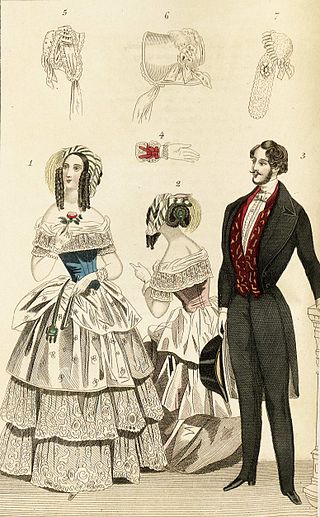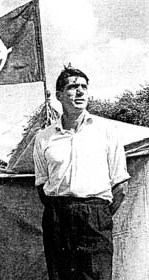This article includes a list of general references, but it lacks sufficient corresponding inline citations .(August 2022) |

Neo-Victorianism is an aesthetic movement that features an overt nostalgia for the Victorian period.
This article includes a list of general references, but it lacks sufficient corresponding inline citations .(August 2022) |

Neo-Victorianism is an aesthetic movement that features an overt nostalgia for the Victorian period.
Examples of crafts made in this style would include push-button cordless telephones made to look like antique wall-mounted phones, CD players resembling old time radios, Victorianesque furniture, and Victorian era-style clothing.
In neo-romantic and fantasy art, one can often see the elements of Victorian aesthetic values. There is also a strongly emerging genre of steampunk art. McDermott & McGough are a couple of contemporary artists whose work is all about a recreation of life in the nineteenth century: they only use the ultimate technology available, and since they are supposed to live anachronistically, this means the use of earlier photographic processes, and maintaining the illusion of a life stuck in the ways of a forgotten era. [1]
Neo-Victorian works of fiction are creative narrative works set in the Victorian period, but written, interpreted or reproduced by more contemporary artists.
Many neo-Victorian novels have reinterpreted, reproduced and rewritten Victorian culture. Significant texts include The French Lieutenant’s Woman (John Fowles, 1969), Possession (A. S. Byatt, 1990), Arthur and George (Julian Barnes, 2005), Dorian, An Imitation (Will Self, 2002) Jack Maggs (Peter Carey, 1997), Wide Sargasso Sea (Jean Rhys, 1966). Recent neo-Victorian novels have often been adapted to the screen, from The French Lieutenant’s Woman (Karel Reisz, 1981) to the television adaptations of Sarah Waters ( Tipping the Velvet , BBC2, 2002, Fingersmith , BBC1, 2005, Affinity ITV, 2008) and Michel Faber ( The Crimson Petal and the White , BBC 1, 2011). These narratives may indicate a 'sexsation' of neo-Victorianism, [2] and have been called "in-yer-face" neo-Victorianism (Voigts-Virchow). [3]
Recent productions of neo-Victorianism on screen include Guy Ritchie’s Sherlock Holmes films and TV series such as Sherlock , Ripper Street , Whitechapel , Murdoch Mysteries and Penny Dreadful . The neo-Victorian formula can be expanded to include Edwardian consumer culture ( Downton Abbey , The Paradise and Mr Selfridge ).
Many who have adopted Neo-Victorian style have also adopted Victorian behavioural affectations, seeking to imitate standards of Victorian conduct, pronunciation, interpersonal interaction. Some even go so far as to embrace certain Victorian habits such as shaving with straight razors, riding penny farthings, exchanging calling cards, and using fountain pens to write letters in florid prose sealed by wax. Gothic fashion sometimes incorporates Neo-Victorian style.
Neo-Victorianism is embraced in, but also quite distinguished from, the Lolita, Aristocrat and Madam fashions popular in Japan, and which are becoming more noticeable in Europe.
Neo-Victorian aesthetics are also popular in the United States and United Kingdom among cultural conservatives and social conservatives. [4] Books such as The Benevolence of Manners: Recapturing the Lost Art of Gracious Victorian Living call for a return to Victorian morality. [5] The term Neo-Victorian is also commonly used in a derogatory way towards social conservatives.
Many of the things that seem commonplace in modern life began in the Victorian era, such as sponsorship, sensational journalism and popular merchandise. [6]
In September 2007, The University of Exeter explored the phenomenon in a major international conference titled Neo-Victorianism: The Politics and Aesthetics of Appropriation. [7] Academic studies include Neo-Victorianism: The Victorians in the Twenty-First Century, 1999–2009. [8]
Other foundational texts of neo-Victorian criticism are Kucich and Sadoff (2000), Kaplan (2007), Kohlke (2008-), Munford and Young (2009), Mitchell (2010), Davies (2012), Whelehan (2012), Kleinecke-Bates (2014), Böhm-Schnitker and Gruss (2014), Tomaiuolo (2018), and others.
Neo-Victorianism can also be seen in the growing steampunk genre of speculative fiction and in music performers such as Emilie Autumn. Neo-Victorianism is also popular with, and in many ways prefigured by, those who are interested in Victoriana and historical reenactment.
Neo-Victorian details appear in The Diamond Age by Neal Stephenson, [9] in which Neo-Victorians are one of the main groups of protagonists.
Carnival Diablo is a Neo-Victorian circus sideshow that has been touring North America for 20 years.
Unhallowed Metropolis is a roleplaying game based in a Neo-Victorian setting.

Steampunk is a subgenre of science fiction that incorporates retrofuturistic technology and aesthetics inspired by, but not limited to, 19th-century industrial steam-powered machinery. Steampunk works are often set in an alternative history of the Victorian era or the American "Wild West", where steam power remains in mainstream use, or in a fantasy world that similarly employs steam power.

Gothic fashion is a clothing style worn by members of the goth subculture. A dark, sometimes morbid, fashion and style of dress, typical gothic fashion includes black dyed hair and black clothes. Both male and female goths can wear dark eyeliner, dark nail polish and lipstick, and dramatic makeup. Styles are often borrowed from the Elizabethans and Victorians. BDSM imagery and paraphenalia are also common. Gothic fashion is sometimes confused with heavy metal fashion and emo fashion.

Victorian fashion consists of the various fashions and trends in British culture that emerged and developed in the United Kingdom and the British Empire throughout the Victorian era, roughly from the 1830s through the 1890s. The period saw many changes in fashion, including changes in styles, fashion technology and the methods of distribution. Various movement in architecture, literature, and the decorative and visual arts as well as a changing perception of gender roles also influenced fashion.

Retrofuturism is a movement in the creative arts showing the influence of depictions of the future produced in an earlier era. If futurism is sometimes called a "science" bent on anticipating what will come, retrofuturism is the remembering of that anticipation. Characterized by a blend of old-fashioned "retro styles" with futuristic technology, retrofuturism explores the themes of tension between past and future, and between the alienating and empowering effects of technology. Primarily reflected in artistic creations and modified technologies that realize the imagined artifacts of its parallel reality, retrofuturism can be seen as "an animating perspective on the world".

Andrew Fountaine was an activist involved in the British far right. After military service in a number of conflicts, Fountaine joined the Conservative Party and was selected as a parliamentary candidate until his outspoken views resulted in his being disowned by the party.
The Third Position is a set of neo-fascist political ideologies that were first described in Western Europe following the Second World War. Developed in the context of the Cold War, it developed its name through the claim that it represented a third position between the capitalism of the Western Bloc and the communism of the Eastern Bloc.
Since the advent of the cyberpunk genre, a number of cyberpunk derivatives have become recognized in their own right as distinct subgenres in speculative fiction, especially in science fiction. Rather than necessarily sharing the digitally and mechanically focused setting of cyberpunk, these derivatives can display other futuristic, or even retrofuturistic, qualities that are drawn from or analogous to cyberpunk: a world built on one particular technology that is extrapolated to a highly sophisticated level, a gritty transreal urban style, or a particular approach to social themes.

The Biedermeier period was an era in Central Europe between 1815 and 1848 during which the middle classes grew in number and the arts began to appeal to their sensibilities. The period began with the end of the Napoleonic Wars in 1815 and ended with the onset of the Revolutions of 1848.

Victoriana is a term used to refer to material culture related to the Victorian period (1837–1901). It often refers to decorative objects, but can also describe a variety of artifacts from the era including graphic design, publications, photography, machinery, architecture, fashion, and Victorian collections of natural specimens. The term can also refer to Victorian-inspired designs, nostalgic representations, or references to Victorian-era aesthetics or culture appropriated for use in new contexts

Jess Nevins is an American author and research librarian best known for annotated guides and encyclopedias covering Victoriana, comic books, genre fiction and pulp fiction. Among Nevin's books are Encyclopedia of Fantastic Victoriana,Horror Fiction in the 20th Century and Encyclopedia of Golden Age Superheroes. He has been a recipient and finalist for a number of honors, including the World Fantasy, Sidewise, and Locus Awards.
Operatic pop or popera is a subgenre of pop music that is performed in an operatic singing style or a song, theme or motif from classical music stylized as pop. The subgenre is often performed by classical crossover singers and acts, although that field is much broader in the types of music it encompasses. "Popera" performances, such as those by the Three Tenors, have reached larger audiences and brought in greater profits than typical for operatic music.
Gerry Smyth is an academic, musician, actor and playwright born in Dublin, Ireland. He works in the Department of English at Liverpool John Moores University, where he is Professor of Irish Cultural History. His early publications were mainly in the field of Irish literature, although since 2002 he has also written widely on the subject of Irish music.
Stephen John Hunt is a British professor of sociology at the University of the West of England. Prior to his appointment at the University of West England in 2001, Hunt had taught at the Sociology Department at the University of Reading for thirteen years, as well as in the Religious Studies Department at the University of Surrey, Roehampton.
Heritage film is a critical term to refer to a cluster or cycle of late 20th-century British films that were argued to depict the United Kingdom of the pre-World War II decades in a nostalgic fashion. Although this term was originally used to discuss the film genre polemically, its use has broadened out, and it is now also used more loosely to refer to period films with high-quality visual production values, including those produced in France, other European countries and beyond.

Steampunk fashion is a subgenre of the steampunk movement in science fiction. It is a mixture of the Victorian era's romantic view of science in literature and elements from the Industrial Revolution in Europe during the 1800s. Steampunk fashion consists of clothing, hairstyling, jewellery, body modification and make-up. More modern ideals of steampunk can include t-shirts with a variety of designs or the humble jeans being accessorised with belts and gun holsters.

The Enola Holmes Mysteries is a young adult fiction series of detective novels by American author Nancy Springer, starring Enola Holmes as the 14-year-old sister of an already famous Sherlock Holmes, twenty years her senior. There are nine books in the series, and one short story all written from 2006–2023. This pastiche series borrows characters and settings from the established canon of Sherlock Holmes, but the Enola character is Springer's creation and specific to this series.

Angela McRobbie is a British cultural theorist, feminist, and commentator whose work combines the study of popular culture, contemporary media practices and feminism through conceptions of a third-person reflexive gaze. She is a professor of communications at Goldsmiths College, University of London.

Dieselpunk is a retrofuturistic subgenre of science fiction similar to steampunk or cyberpunk that combines the aesthetics of the diesel-based technology of the interwar period through to the 1950s with retro-futuristic technology and postmodern sensibilities. Coined in 2001 by game designer Lewis Pollak to describe his tabletop role-playing game Children of the Sun, the term has since been applied to a variety of visual art, music, motion pictures, fiction, and engineering.
Jane Chapman is a British academic, professor of communications at the University of Lincoln, a research associate and a former fellow at Wolfson College, Cambridge and the Centre of South Asian Studies, Cambridge. She is the author of twelve books and over 35 academic articles and book chapters.

A Dickens fair is a weekend or multi-day gathering open to the public which attempts to recreate a Victorian English setting reminiscent of the novels of Charles Dickens. Events may be outdoor, indoor or a combination of the two. Many are Christmas-themed, a reflection of the enduring legacy of Dickens' 1843 novella A Christmas Carol. The fairs generally include costumed participants, musical and theatrical acts, and art, handicrafts, food and drink for sale.